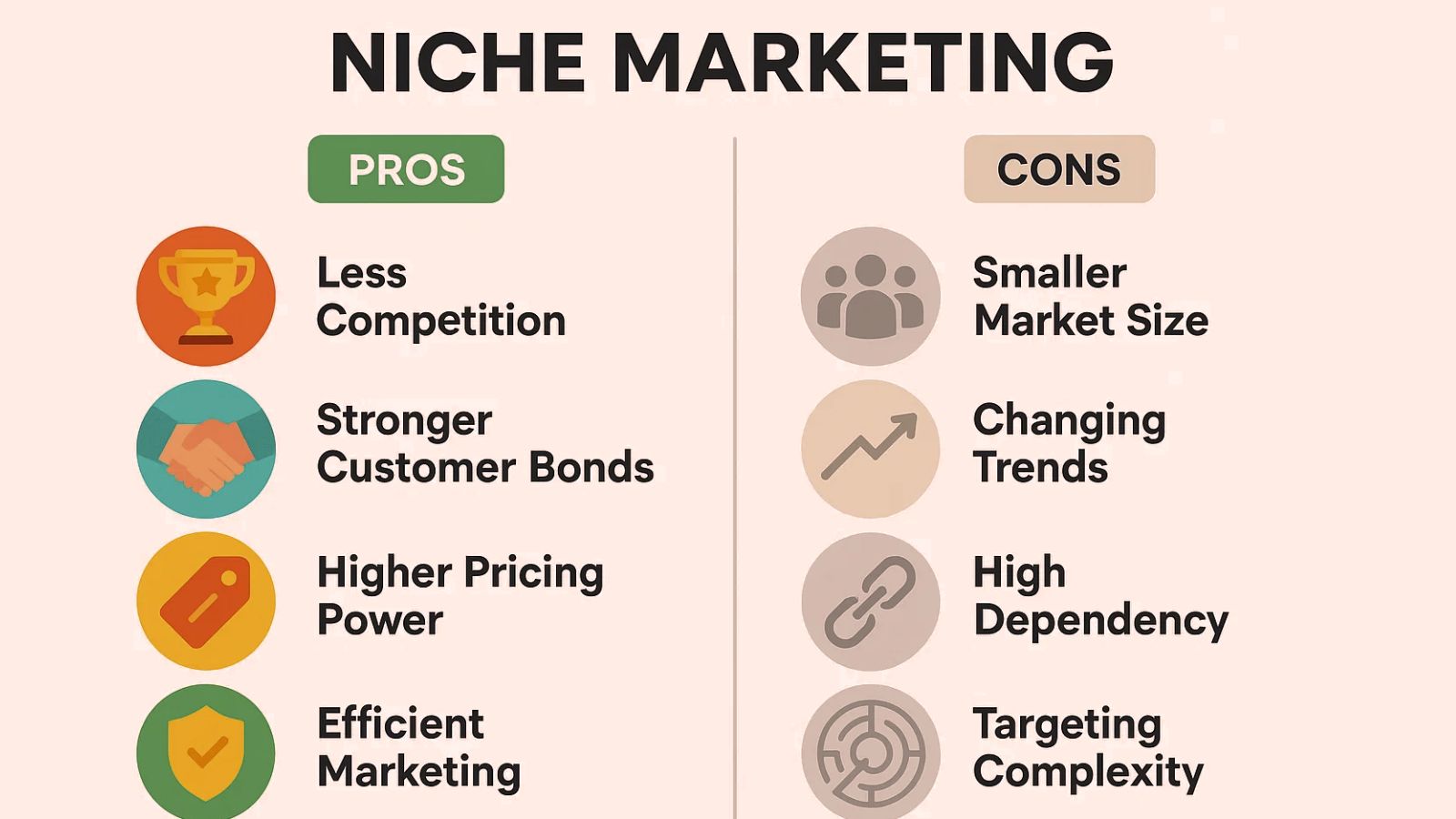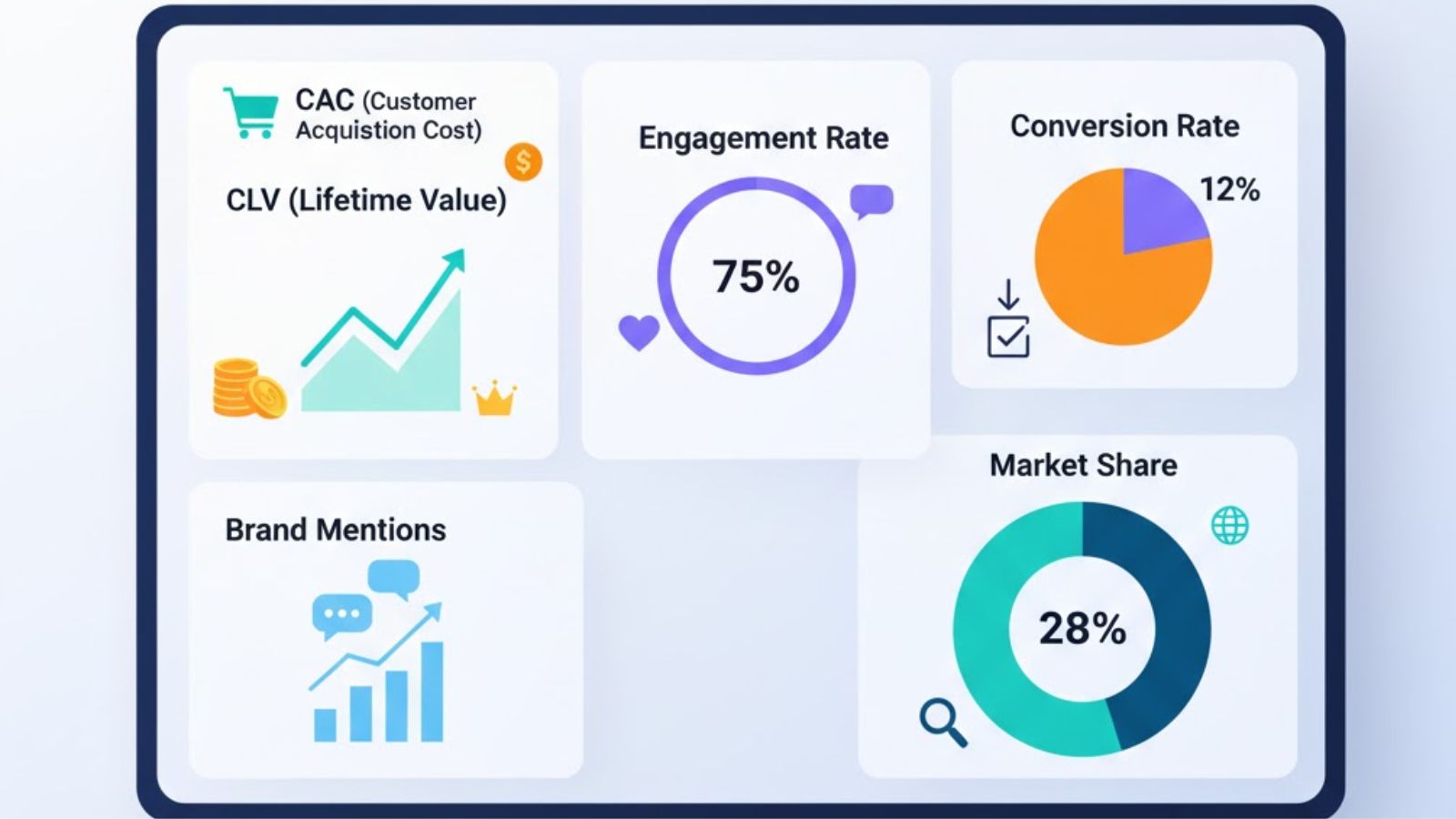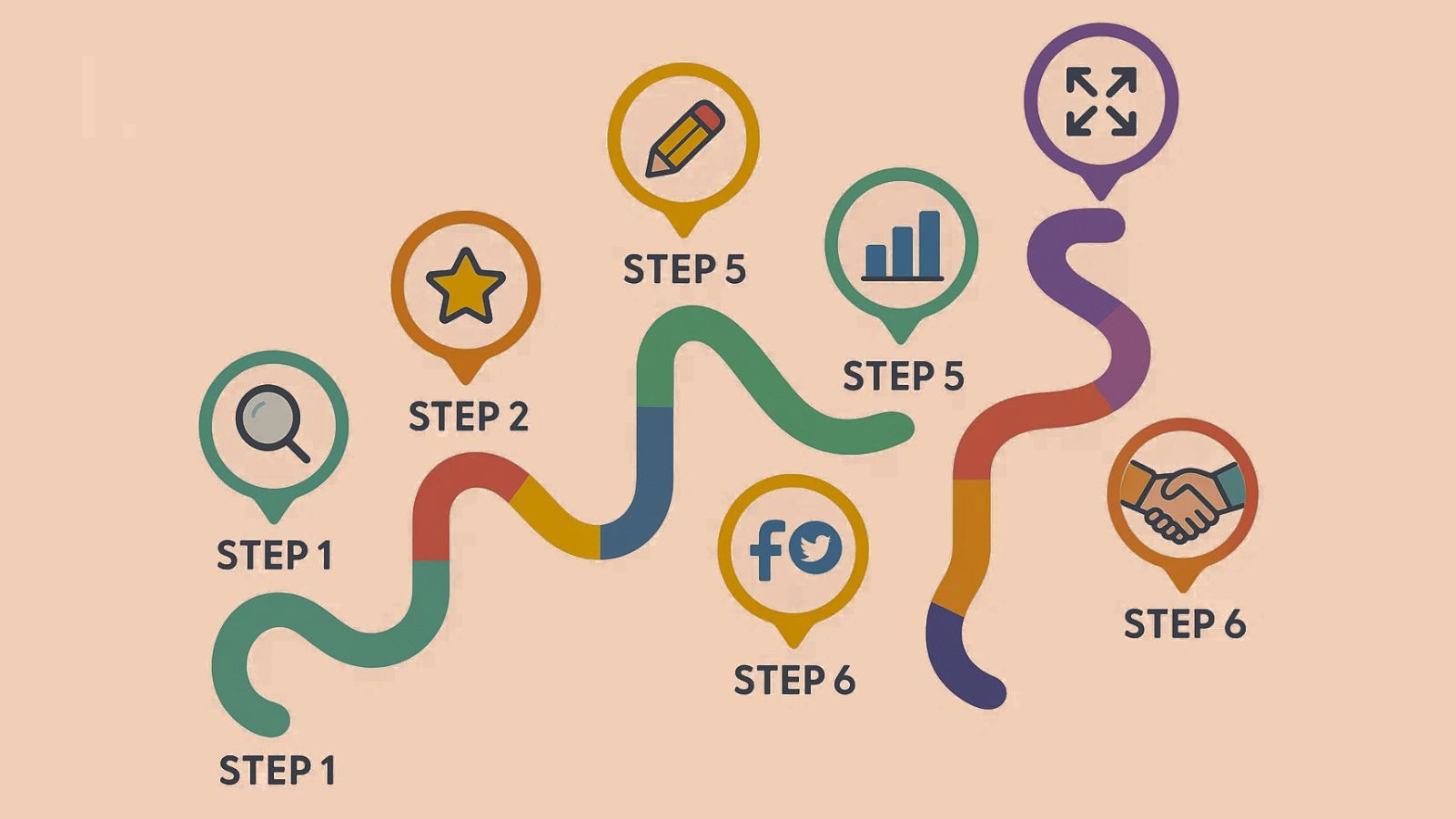Trying to sell to everyone usually means you end up selling to no one. That’s exactly why niche marketing has become such a game-changer for businesses of all sizes.
Instead of competing with every brand under the sun, you focus on a specific group of people who genuinely need what you’re offering.
Think about it this way: would you rather be a small fish in a massive ocean or the biggest fish in a smaller pond?
Niche marketing is all about finding your pond and owning it completely.
In this guide, we’ll explore what is niche marketing, why it matters, and how to reach your ideal customers without burning through your marketing budget.
Listen Podcast Now!
What Does Niche Market Really Mean?
To understand niche market meaning, imagine the overall market as a large pie.
A niche market is one focused slice of that pie, where customers share specific interests, values, or pain points.
Instead of targeting “everyone who drinks coffee,” you might focus on “busy professionals who want organic, fair-trade cold brew delivered to their office.”
The more specific you get, the better you can tailor your products, messaging, and branding to serve that audience perfectly.
The beauty of targeting a niche market is that you’re not trying to appeal to everyone — you’re becoming the perfect solution for a select group. These customers often pay more because general options simply don’t meet their needs.
For instance, left-handed people make up about 10% of the population, and for years, they struggled with right-handed tools.
Companies that created left-handed scissors, notebooks, and kitchen utensils filled a gap, an excellent niche product example that shows how specificity leads to success.
Similarly, Automation Niches work the same way; instead of automating everything for everyone, businesses can focus on specific automation needs like social media scheduling, eCommerce workflow automation, or email follow-ups.
By catering to a precise group, these automation-focused solutions can deliver higher value and build stronger brand loyalty.
Understanding Niche Marketing and Its Benefits:
So, what is niche marketing in practice? It’s a marketing approach that focuses on a well-defined audience segment instead of trying to reach everyone.
It’s about crafting messages that resonate deeply with the right people.
Rather than shouting into a noisy crowd, you’re having a meaningful conversation with someone who already cares about what you’re saying.
Here’s what makes niche marketing powerful:
- Laser-Focused Messaging: Speak directly to your audience’s unique desires and problems, no one-size-fits-all fluff.
- Custom-Fit Products: Build offerings from the ground up for your niche audience instead of tweaking generic ones.
- Smart Channel Selection: Show up where your audience hangs out, not everywhere.
- Community Building: Create a sense of belonging where customers feel understood and valued.
Why Niche Marketing Actually Matters?
Consumers are bombarded with thousands of ads every day, and most get ignored. Niche marketing cuts through the noise because it’s relevant.
When someone sees a message that directly addresses their challenges, they pay attention. It’s like hearing your name in a crowded room; you can’t help but look.
For smaller brands, niche marketing is a competitive edge. You don’t need huge ad budgets; you need precision.
By knowing your audience better than anyone else, you can connect on a personal level and convert more effectively. It’s also more cost-effective.
When you target the right people, your conversion rates go up, your ad costs go down, and your customers stick around longer because your products truly fit their needs.
In short, when you find your niche, marketing stops being a struggle and starts feeling like a genuine connection.
Real-World Niche Marketing Examples:
Now, let’s look at some niche marketing examples that show how powerful this strategy can be in action:
- Beardbrand: Instead of being just another men’s grooming company, they focused exclusively on bearded men. From their beard oils to their YouTube tutorials, they built a thriving culture around beard care and style, a classic niche product example.
- Outdoor Voices: Rather than competing with Nike or Adidas, they targeted “recreational athletes,” people who love being active for fun, not competition. Their “Doing Things” philosophy became a lifestyle.
- ThirdLove: The lingerie brand revolutionized the industry by catering to women who don’t fit standard bra sizes. They offered half-cup sizes and a fit-first experience that mainstream brands ignored.
- Dollar Shave Club: They disrupted the razor market by targeting budget-conscious men tired of overpaying for blades. Their witty campaigns and subscription model turned a niche idea into a billion-dollar brand.
These examples of niche marketing prove you don’t need to appeal to everyone. You just need to be the best option for someone.
How to Find Your Perfect Niche Market?
Finding your niche requires insight, not guesswork. Here’s how to do it right:
1. Start With What You Know:
The best niches often come from personal experience. What problems have you faced?
What communities do you belong to?
When you understand your audience’s world from the inside, authenticity shines through, and authenticity sells.
2. Look for the Gaps:
Every market has pain points that aren’t being addressed. Browse product reviews and forums to see what people are complaining about. These gaps are business opportunities waiting to be filled.
3. Ensure Profitability:
Passion matters, but so does profit. Make sure your niche is big enough to sustain your business and that your audience is willing to spend on premium solutions.
4. Study Your Competitors:
Some competition is good—it proves there’s demand. Identify what your competitors do well and where they fall short. Your niche might lie in doing something better or more personalized.
5. Test Before You Commit:
Validate your idea before fully launching. Run small tests, like surveys, polls, or sample campaigns, to confirm that real people will pay for your solution.
Smart Strategies to Reach Your Niche Audience:
Once you’ve defined your market, here’s how to reach them effectively:
1. Create Valuable, Targeted Content:
Develop blogs, videos, or social posts that answer your audience’s specific questions.
For instance, if you sell productivity tools for freelancers, focus on time-tracking challenges or client communication hacks, not generic “business tips.” When your content resonates, it spreads naturally within your niche community.
Tools like content planners or analytics apps can help identify which topics engage your audience the most.
2. Find Where They Hang Out:
Your audience already exists online, in Reddit threads, Facebook groups, Discord communities, or niche industry forums.
Join these spaces, participate authentically, and become part of the conversation. Platforms that track engagement and trends can make this process much easier.
3. Partner With Micro-Influencers:
Rather than chasing celebrities, collaborate with influencers deeply embedded in your niche. Their smaller, loyal audiences are far more likely to engage and convert.
4. Target Niche Keywords:
Use long-tail search terms that reflect your audience’s specific needs. For example, instead of “running shoes,” target “barefoot running shoes for women with flat feet.”
These keywords may have lower search volume but higher intent. SEO tools can help you find the exact phrases your niche is searching for.
5. Attend Niche Events:
Webinars, online meetups, and local expos connect you directly with your audience. These interactions build trust faster than ads ever could.
6. Build an Email List:
Email remains one of the most effective tools for nurturing relationships. Segment your subscribers by interest and send personalized updates, offers, and tips that matter to them.
Email marketing tools make it easier to automate and tailor these messages for maximum impact.
Streamline Your Niche Marketing Efforts. To manage and execute these strategies efficiently, tools that allow scheduling, monitoring, and analyzing your social presence can be a huge help.
For example, Socinator offers features that simplify content planning, audience engagement, and analytics tracking, all in one place, making it easier to stay consistent and connected with your niche audience.
How Can Socinator Make Niche Marketing Easier?
Managing multiple social media accounts while running a business can feel overwhelming.
That’s where Socinator steps in as your go-to social media automation tool. It helps you maintain a consistent presence across the platforms where your niche audience is most active, without the burnout.
Why Socinator Works Perfectly for Niche Marketing?
- Multi-Platform Management: Manage 9+ social media platforms, including Facebook, Instagram, Twitter, LinkedIn, Pinterest, YouTube, and more, all from a single dashboard.
- Targeted Engagement on Autopilot: Automatically follow, like, and comment on accounts that match your niche profile, ensuring you connect with the right audience.
- Scheduled Posting: Plan and automate your content calendar weeks in advance, so you never miss your audience’s peak engagement times.
- Smart Analytics: Understand what works best for your audience and refine your strategy with data-driven insights.
In niche marketing, precision and consistency are everything—and Socinator delivers both, saving you time while helping your brand grow.
The Pros and Cons of Niche Marketing:
 The Advantages:
The Advantages:
- Less Competition: With fewer rivals, it’s easier to stand out.
- Stronger Customer Bonds: You understand your audience deeply, so relationships last longer.
- Higher Pricing Power: Niche buyers pay more for tailored solutions.
- Efficient Marketing: You spend less reaching people who truly care.
- Authority and Expertise: Consistent niche focus builds credibility fast.
The Challenges:
- Smaller Market Size: Niches limit total reach, which can cap revenue.
- Changing Trends: Market shifts can impact demand quickly.
- High Dependency: If one niche slows, your business might feel it.
- Targeting Complexity: Reaching a narrow audience requires strategy and patience.
Understanding these trade-offs helps balance focus with flexibility.
how-to-succeed-in-niche-marketing-a-practical-approach: A Practical Approach:
Here’s a quick roadmap to dominate your niche effectively:
Step 1: Define Your Niche Clearly:
Go beyond demographics. Understand your audience’s lifestyle, frustrations, values, and goals. Think about their daily routines, the problems that frustrate them, and the aspirations they chase.
The deeper your understanding, the more precisely you can position your products and messaging to truly resonate with them.
Step 2: Identify Your Unique Value:
Determine why you’re the obvious choice. Maybe it’s your expertise, community connection, or personalized service.
Focus on what makes you different from competitors and what specific problem you solve better than anyone else. This unique value is the core of your brand story.
Step 3: Plan Strategic Content:
Map out a content strategy aligned with your niche’s interests. Combine educational, entertaining, and promotional posts for variety.
Include tutorials, how-tos, behind-the-scenes glimpses, or case studies that make your audience feel seen and understood.
This consistency builds trust and positions you as an authority in your niche.
Step 4: Choose the Right Platforms:
Focus on where your audience truly engages; being exceptional on two platforms beats being average on six.
Research where your niche spends their time online and prioritize those channels. This ensures your energy and resources have maximum impact.
Step 5: Launch, Measure, and Adapt:
Use analytics to track engagement, conversions, and reach. Double down on what works and drop what doesn’t.
Experiment with different types of content, posting times, and campaigns to see what resonates best. Learning and adapting are key to staying relevant.
Step 6: Build Relationships:
Engage in real conversations. Comment, reply, and show genuine interest—this turns followers into loyal fans.
Encourage feedback, ask questions, and recognize your top supporters. When your audience feels heard and valued, they’re more likely to become advocates for your brand.
Step 7: Optimize and Expand:
Once you’ve captured your niche, consider expanding to adjacent audiences. For example, a pet brand for dog owners could later include cat owners or small pet accessories.
Gradually broadening your reach allows growth without losing the loyal base that made you successful in the first place.
Also Read:
9+ Best YouTube Automation Niches With High-Profit Potential
5 Impactful Tips To Find The Right Influencers In Your Niche
What Really Makes a Difference in Your Strategy?
 Niche success depends on measuring meaningful results:
Niche success depends on measuring meaningful results:
- Customer Acquisition Cost (CAC): Should decrease as targeting improves.
- Customer Lifetime Value (CLV): Loyal niche customers tend to buy repeatedly.
- Engagement Rate: Reflects how much your audience connects with your message.
- Conversion Rate: Indicates the strength of your niche targeting and offers.
- Brand Mentions and Sentiment: Track how your niche community talks about you.
- Niche Market Share: Even small audiences matter if you dominate your space.
These insights help refine your strategy and fuel consistent growth.
Conclusion:
Understanding niche markets and how to reach them can transform your brand from struggling for attention to being the trusted expert in your space.
It’s not about limiting your potential; it’s about focusing energy where it delivers maximum impact. Identify underserved segments, understand their needs deeply, and serve them better than anyone else.
When you combine strategic focus, authentic communication, and the right tools like Socinator, your business stops chasing attention and starts commanding it.
So go find your niche, own your pond, and become the go-to name in your market.
FAQ’s:
Q1: How do I know if my niche is too small?
Estimate your total market size and potential revenue. If realistic penetration meets your goals, it’s viable. If not, expand slightly.
Q2: Can I target multiple niches at once?
You can, but it’s wiser to master one first. Each niche needs unique messaging, so start narrow and scale gradually.
Q3: How long before I see results?
Usually 6–12 months of focused effort. However, if your product solves a high-demand problem, you might gain traction sooner.
Q4: What if competitors copy my strategy?
Stay ahead through innovation, deep community engagement, and authenticity. Relationships can’t be copied.














